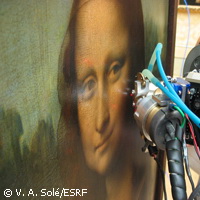Want to paint like da Vinci? Here's how...
EU-funded scientists have discovered the secret techniques used by Leonardo da Vinci to create seven of his masterpieces including the renowned Mona Lisa. Their study represents the first time that a quantitative chemical analysis has ever been conducted on the paintings, revealing the way in which da Vinci composed and layered each of his works of art. The research results are published in the journal Angewandte Chemie International Edition. The EU-ARTECH ('Access, research and technology for the conservation of the European cultural heritage') project was funded to the tune of EUR 4.37 million under the Research Infrastructures budget line of the EU's Sixth Framework Programme (FP6). A team led by the laboratoire du Centre de recherche et de restauration des musées de France conducted the analysis (without extracting paint samples) on seven of da Vinci's paintings currently housed at the Louvre Museum in Paris, France: the Virgin of the Rocks; the Mona Lisa; Saint John the Baptist; Annunciation; Bacchus; Belle Ferronnière; and Saint Anne, the Virgin, and the Child. Born in the 15th century during the European Renaissance, Leonardo da Vinci is arguably the greatest painter that ever lived. He was also a highly competent scientist, architect and inventor. Perhaps it was this range of skills and his inventive mind that allowed him to create a variety of subtle optical effects known as 'sfumato' (from the Italian verb meaning to soften, shade and disappear). Sfumato is one of four painting methods that typify Renaissance art (the others being cangiante, chiaroscuro and unione). Da Vinci himself described the technique as smoke, where lines are blurred, softened and blended to create a hazy effect of depth and shadow. In the past, experts have been able to provide insight into how the technique is applied through detailed observations, optical measurements and reconstitutions. Results have, however, been limited since tests often require samples to be extracted. For the purposes of their study, the scientists used a non-invasive chemical analytical method called X-ray fluorescence spectroscopy, which allowed them to concisely examine the layers of paint in the seven artworks as well as their chemical composition (the experts focused mainly on the faces where sfumato is most evident). They found that the master used 30 ultrathin layers of paint and glaze on his works, adding up to a total thickness of between 30 and 40 micrometres (half the thickness of a strand of just 1 human hair). The researchers also discovered that da Vinci was always developing and trying new methods. In producing shading effects for the Mona Lisa, for example, he used manganese oxide, whereas he used copper in others. The study, which was developed in collaboration with the European Synchrotron Radiation Facility (ESRF) in France, was conducted at the Louvre after hours. The five-year EU-ARTECH project concluded in May 2009. Its aim was to improve collaborative activities between 13 European infrastructures that operate in the field of artwork conservation and cultural heritage, and administer interdisciplinary programmes with conservators, archaeologists, scientists and art historians. Extension activities are now being conducted under CHARISMA ('Cultural heritage advanced research infrastructures: synergy for a multidisciplinary approach to conservation/restoration'). The project, which has been funded with EUR 7.6 million by the Research Infrastructures programme of the Seventh Framework Programme (FP7), brings together art and science experts to design and establish new instrumentations and methodologies for the conservation of art and culture.
Countries
France



